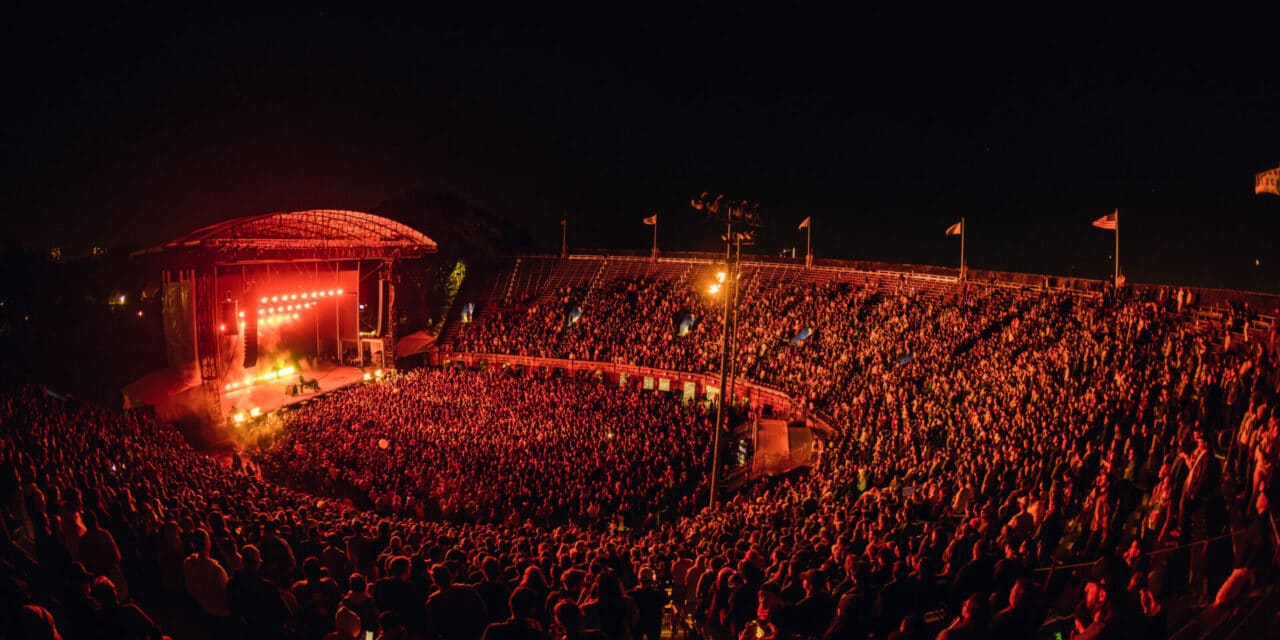XXL: Jamie XX played Forest Hills Stadium in Queens, New York, last summer. (Courtesy venue)
A Rich History; ‘Strange and Weird’ Rebirth
For a century Forest Hills Stadium in Queens, New York, has been the home of superstars of tennis and music.
America’s first tennis stadium was constructed for the U.S. Open in 1923 and has hosted groundbreaking players, including Black athletes Arthur Ashe and Althea Gibson, whose Grand Slam wins broke the sport’s color barrier; and some of mainstream music’s most iconic moments, including The Beatles, who arrived by helicopter in 1964; Bob Dylan who played the stadium shortly after going electric at the Newport Jazz Festival in 1965; and Jimi Hendrix who was still an emerging talent when he was booed after opening for The Monkees in 1967.
At the forefront of the current rebirth of the 100-year-old Romanesque treasure is Mike Luba of Tiebreakers Productions, who took over managing the then-dormant stadium from the West Side Tennis Club in 2013 and has a lease with the WSTC through 2032.
“Everything about that place was this weird combination of a boondoggle meets a rabbit hole,” quipped Luba, who as co-president of Madison House Presents has been a central figure in sold-out historic events, including The Grateful Dead’s 50th Anniversary “Fare Thee Well” show at Soldier Field and Chance the Rapper’s first Magnificent Coloring Day concert at U.S. Cellular Field, now Guaranteed Rate Field, in Chicago.
Celebrating 10 decades of music and sports history this concert season, Forest Hills Stadium has hosted a record 30 shows over five months, concluding Oct. 8 with the food and music festival EEEEEATSCON New York.
Bowery Presents handles the marketing, venue operations and ticketing with AXS as the ticketing platform at Forest Hills Stadium.
Luba, AEG Presents’ Don Sullivan and the AEG subsidiary, Bowery Presents booking team (including Joy Hubbard who holds the calendar for the venue), have historically booked most of the shows. Forest Hills is an open venue to all promoters.
Performers during the centennial season included first-timers, former openers who are now headliners and returning favorites such as The Strokes, boygenius, Zach Bryan, Bert Kreischer, James Blake, Steve Lacey, Weezer, Queens of the Stone Age, Kevin Hart and Jason Mraz.
“It feels like a family reunion,” Luba said.
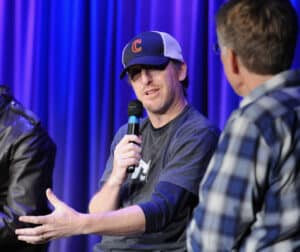
QUEENS GAMBIT: Producer Mike Luba speaks at an event at the Grammy Museum in 2012. (Getty Images)
About 20% of the performing artists had Billboard Top 10 hits. Close to 45% of the shows were sold out at the 13,600-capacity venue. According to Pollstar Boxoffice reports, Forest Hills Stadium’s average show gross is $986,000 with 11,681 tickets sold per show. Recent highlights include Dave Matthews Band, which grossed $1.7 million in June 2023. Van Morrison brought in $1.5 million in Sept. 2022 and EDM act Odesza grossed $2.18 million over two nights.
“Forest Hills is one of the top venues in the world,” said Kirk Sommer, partner and global co-head of music for WME. “It is steeped in history and masterfully updated with complete integrity intact. The vibe is palpable and embraced by artists and fans alike. Everyone feels welcome and every event feels like an event.”
Luba said, “The beauty of the place is that it was built at the dawn of electricity as a place to watch tennis. Everywhere you sit is great. For a place that’s almost 14,000 capacity, it feels like a 7,000-seater. So, it has this crazy double energy. When you get to the top, if you look over the back you get a straight shot to lower Manhattan and you can see the Freedom Tower with the moon rising right above it.”
When the stadium was built, Long Island was the pass-through for bootleg alcohol destined for the city’s speakeasies during Prohibition. At the time, there was a clubhouse and grass courts and little else, but there were future plans, including a nearby train stop. Today, concertgoers take the Long Island Railroad or the subway to Forest Hills. The venue is a 14-minute transit ride from Manhattan and equally convenient for residents of Nassau and Suffolk counties.
“New York is a competitive market of course, but there aren’t any other permanent outdoor venues in this capacity range that are actually within the five boroughs,” said Mike Greisch, senior vice president of talent agency Wasserman Music, which represents Phish among other acts. “The amphitheaters outside the city are great for serving the fans who live outside the city, and some fans from the city go to those shows as well, but Forest Hills is unique in that you can take the F train from Midtown and be there in 20 minutes and see a big outdoor show. Combine that with the incredible history of the venue and the feeling of stepping back in time when you walk around the neighborhood, the tennis club, and the stadium itself, you get a singular experience for fans and artists.”
Fan parking may be non-existent, but production needs are a priority. “It can be a much easier day than some modern arenas,” said Sommer, who represents some of the biggest stars in music.
Even at 100 years old, the venue is acoustically pristine. The infrastructure keeps sound in the bowl and stops it from spilling over the top, allowing for full-blown concert volume inside the venue that doesn’t disrupt the neighborhood.
“We really approach it that we are stewards of the place and if we can just let it be itself, they got it right at that time in the ‘20s and it’s really magical,” Luba said. “We try to keep as true to what it is as possible.”
A FATEFUL CALL
Luba’s caretaking mission had a rocky start. In 2012, he got a call from pop rock band Phoenix, which already had a sold-out Madison Square Garden on the books and was looking for an interesting additional play in the market.
“Part of my real job is I work with bands around the world when they have crazy ideas that don’t make sense logistically or financially, for any reason other than they are really important to the band,” Luba said. “I have a small ninja team of folks who try to help make those missions happen for the bands.”\
Luba grew up in Long Island and was “peripherally aware” of the urban legend of Forest Hills Stadium. His parents, who went to Queens College in New York, had seen Simon and Garfunkel at the stadium on their second date. Luba cold called the pro shop at the West Side Tennis shop. The head pro at the time answered the phone.
“He said, ‘Look I don’t know what the hell you are talking about or who you are, but your timing is pretty good,’” Luba recalled. After 15 years of en
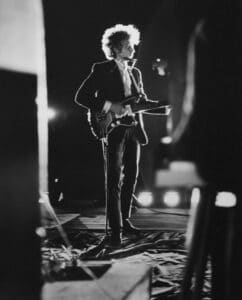
TAMBOURINE MAN: Bob Dylan played Forest Hills in 1965 (pictured), and was notably in attendance for The Beatles’ 1964 gig as well. (Courtesy venue)
tertaining bids from big New York developers to sell off the stadium or turn it into condominiums, the ruling body was short of options because the West Side Tennis Club, which started in 1892, was governed by bylaws that required a super majority of members to be in a room to vote on something of that magnitude. Most of the members were in their 80s and 90s.
“They could never get enough people in the room to vote, and combined with a real preservationist group at the club who were like, ‘There’s no way you are going to knock down the stadium where The Beatles landed a helicopter and played their first big gig in New York, and (had) the Rolling Stones and The Who and Bob Dylan.”
The pro on the phone asked, “What do ya’ got?” Luba responded, “I’ve got no idea, but I’ll come out and look around.”
The venue had been dormant since 1983 and had become a neighborhood dumping ground. Luba and a structural engineer looked around for four hours. Luba recounted their conversation: “He said, ‘I’ll tell you it looks like Baghdad out here, but the honest truth is it’s first-generation Bethlehem steel and concrete and if someone is going to drop a bomb in Queens, this is where I would come to hide out.”
That night, Luba was sitting around the table with a group of childhood friends when he shared he was going to take a run at reviving Forest Hills Stadium.
“One of my buddies, who was the best high school tennis player in New York State when we were kids, turned to me and said, ‘I love tennis and I love music. I’ll help.’ At that point, we were probably eight or nine tequila shots in and I said, ‘All right dude, go home tonight and take $2 million and put in a suitcase and walk out to your backyard and torch it and see how that feels and, if you can stomach that, welcome to the music business.”
The plan was to clean up the stadium and make it safe for patrons, including ripping out the original splintered benches from the 1920s.
“We knew it had an incredible history of being a world-class venue, the home of the U.S. Open from 1923 to 1977, and it’s basically a roman amphitheater so it is really simple and elegant,” Luba said. “We knew it would work.”
Luba convinced popular British folk band Mumford & Sons to be the first concert at the revived Forest Hills in August 2013.
“Those guys had some faith,” Luba said. “They agreed in March and played in August. I think in our heads it was going to be like Pink Floyd in Pompeii.”
They brought in a portable stage. No aisles, just general admission tickets with 17,000 attendees. It was a near disaster. The portable restrooms were in a bad location. People got separated from their groups and couldn’t get back through the crowd.
Wanting to avert a potential crisis, Luba went to the chief of police, a music fanatic who had a Prince tattoo on his knuckles.
“I told him, I’m not super comfortable with what’s going on, do you want me to make an announcement?’ Have the band stop? He put his Prince hands on my shoulders, looked me in the eye and said, ‘Go with God.’ I turned to him and said, ‘I don’t want to go with (expletive) God. I want to go with the New York City police.’”
Officers eventually cleared the aisles for the Mumford fans who had remained cooperative throughout the night. After the show, Luba said they offered refunds to anyone who had a bad experience and returned $450,000.
“I think at that moment, the police and fire chiefs and the EMTs and the city, and the Tennis Club all knew that we were serious,” Luba said. “The stadium immediately revealed what we had to do to fix it and get it right. So, the next year we put in a real stage, we put in seats, the capacity is now 13,600, we have aisles and permanent bathrooms. We did it step by step, but it was almost one and done.”
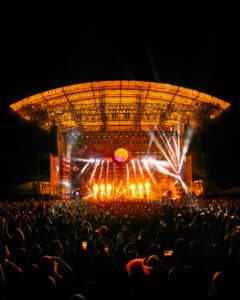
FALL IN: Fall Out Boy performs at Forest Hills Stadium in August 2023. (Getty Images)
Following a lead from Mumford and Sons’ front of house engineer, Luba purchased a repossessed stage in Canada and had it shipped to Queens to be reassembled. “We had to fly eight engineers in from Belgium to put the thing back together, but it has a monster roof, so we can do 18 trucks worth of production,” Luba said.
Sticking with the speakeasy theme, they converted a former U.S. Open snack bar and paint shop with stashes of hand-painted tennis match signs into private speakeasies. The hidden entrance was a portable toilet door that required a 9-volt battery — handed out judiciously by Luba and the team — to open the mechanized latch and enter.
“I love the porta potty for what it is,” said Kerri Silvestri, owner and creative director of OTR Collective, a design and events company that designed the secret VIP lounge at Forest Hills. “People walking by will witness four people walking out of what appears to be a porta potty with beer or a glass of wine in their hands. They are puzzled, ‘How is this happening?’”
Silvestri was part of the rebirth from the start and constructed the artist compound with Amish carpenters in less than a week and decorated spaces with antiques and vintage items from her home. “There were these two to three rooms that surrounded the theater on the bottom floor where the suites currently sit, which were basically closets and storage units,” Silvestri said. “But when put in the context of an amphitheater they were amazing areas to watch a beautiful show.”
Ten private suites with viewing porches and capacities from eight to 50, ring the horseshoe-shaped floor. Each one has its own theme, including the 1939 World’s Fair, which is in the former boiler room, a tennis trophy room, the rock ‘n’ roll bad boy of tennis John McEnroe and the Racoon Lounge, which was once infested with the nocturnal, masked critters.
“It’s the beauty of my job. I’m always on the scout for unique things because I always have a place for it to go — and that’s here,” Silvestri said.
“Wherever you look is something strange or weird,” said Luba. “The tennis part is so serious, but it’s also where Wes Anderson filmed “The Royal Tenenbaums,” so we have a giant plaque that says, ‘Welcome to Forest Hills. On these hallowed grounds Richie Tenenbaum played the worst tennis of his life.’”
With the famous eagle and crest façade, impressive colonnade and greenery, it’s no wonder that Forest Hills Stadium was regarded as New York’s “Colosseum” still preserving the history of legendary moments in sports and music while creating new memories for concertgoers.
As the historic centennial season ends, Luba said, “We feel lucky and thankful. I’ve been all over the world seeing shows and on a nice night, I can look you in the eye and tell you, ‘There is no better place to see a show than Forest Hills Stadium.’”
Forest Hills Meets The Beatles
It was “A Hard Day’s Night” when the Beatles took over Forest Hills Stadium on Aug. 28-29 in 1964.
More than 16,000 fans paid up to $6.50 a ticket and created a non-stop, high-pitched roar that overwhelmed the public address system. Dubbed the “princes of pandemonium,” it was the start of a run of 32 shows in 25 cities over 31 days that would eventually earn the Beatles $1 million.
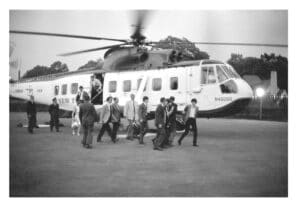
TICKET TO RIDE: The Beatles touch down at Forest Hills Stadium on Aug. 28, 1964, arriving late via private helicopter and requiring a full security detail on and off the stage. (Getty Images)
“This was also a particularly extravagant time to live in or visit Queens, since the Forest Hills Music Festival was in its fifth season and, nearby, the 1964 World’s Fair was in full swing in Flushing Meadows Corona Park,” said Michael Perlman, a fifth-generation resident of Forest Hills and historian.
The band had landed at John F. Kennedy Airport at 3:02 a.m. and were met by 3,000 fans before being whisked away to the Delmonico Hotel on Park Avenue and 59th Street in Manhattan, where more fans were waiting outside. Later, they arrived at Forest Hills Stadium by helicopter, which landed on one of the grass tennis courts. They were late because the pilot didn’t have permission to take off.
According to Perlman, The Fab Four were guarded by 200 police officers inside and another 300 officers on patrol. Private detectives were on the scene, four ambulances were stationed nearby and fire hoses were ready to dampen any outbursts. An eight-foot fence topped by barbed wire protected the stage when the band finally went on at 9:50 p.m.
The Beatles’ 30-minute, 12-song set consisting of“Twist and Shout,” “You Can’t Do That,” “All My Loving,” “She Loves You,” “Things We Said Today,” “Roll Over Beethoven,” “Can’t Buy Me Love,” “If I Fell,” “I Want To Hold Your Hand,” “Boys,” “A Hard Day’s Night,” and “Long Tall Sally.”
A Rich Sports History
America’s first tennis stadium, Forest Hills Stadium was a labor of love – set, match – driven in the 1920s in response to the stature and popularity of Wimbledon in the U.K.
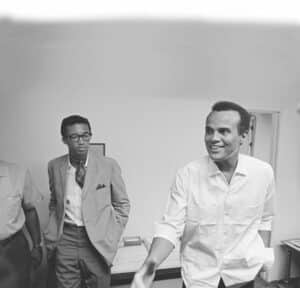
GROUND BREAKER: Arthur Ashe, left, with musician and activist Harry Belafonte, reached the highest level of men’s tennis by winning the first U.S. Open played at Forest Hills Stadium in 1968. (Getty Images)
The West Side Tennis Club originated in 1892 on Manhattan’s west side. After several relocations the $30,000 Tudor-style clubhouse was constructed in 1913 with temporary grandstands for matches, but by late 1917, attendance had outgrown the stands.
At the time, the club and the U.S. Lawn Tennis Association partnered to finance the 14,000-seat Forest Hills Stadium. The Foundation Company, builders of superstructures including bridges, harbor developments, office buildings, tunnels and railroads, began construction of the $150,000 project in April 1923 and it was completed in time for the Davis Cup Challenge that August, according to Michael Perlman, the historian who founded a committee in 2010 to preserve the stadium.
To help finance the development, The New York Times reported on May 22, 1923, that 900 out of 1,500 choicest seats had been reserved under a 10-year subscription plan for $100, where the subscriber would have their name affixed to a metal plate, guaranteeing their seat for major events.
Arthur Ashe and Harry Belafonte, Caesar’s Palace Las Vegas, September 10, 1968. Photo by John G. Zimmerman.
Over the decades, tennis history was made and barriers were broken. Black athletes Arthur Ashe and Althea Gibson’s Grand Slam wins broke the sport’s color barrier. In 1953, Maureen Connolly Brinker was the first woman to win a Grand Slam. Helen Wills Moody won 31 Grand Slams and became the first female American athlete to be recognized as an international celebrity. Forest Hills Stadium was the U.S. Open’s birthplace, where Billie Jean King played the first Open match in 1968.“The greatest reward is witnessing a most historic and picturesque stadium standing at the time of its centennial,” said Perlman, who received the Historic Districts Council’s Grassroots Preservation Award for NYC in 2014. “The Forest Hills Tennis Stadium was no match for the landfill. If it underwent demolition, tennis and music legends who passed on, as well as architect Kenneth Murchison and engineer Charles Landers among other influential WSTC members, would have been turning in their grave.”
